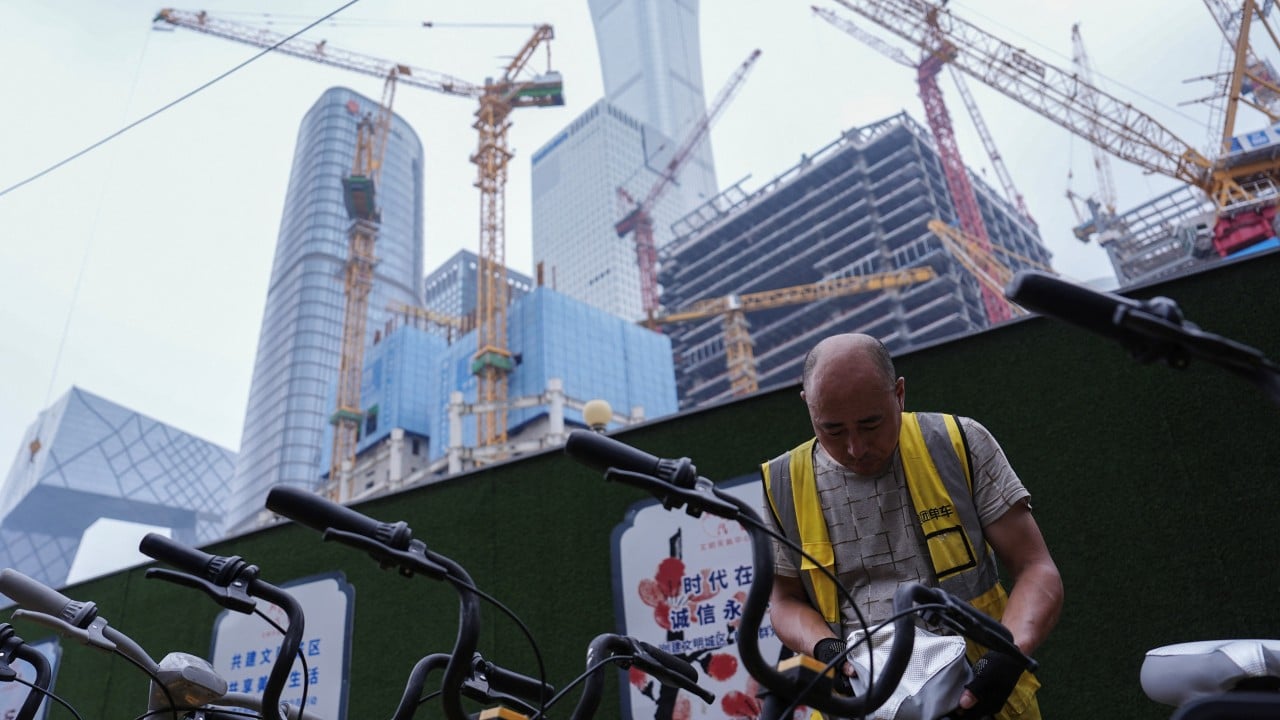If you would like to see more of our reporting, please consider subscribing.
1. GDP slows, but not yet a renewed downturn
China’s economy grew by 4.7 per cent in the second quarter compared to a year earlier – “well below expectations” per analysts – after recording 5.3 per cent growth in the first quarter.
In the first half of the year, China’s gross domestic product grew by 5 per cent year on year, “which keeps China still on pace to achieve its 5 per cent GDP growth target for now”, said Lynn Song, chief economist for Greater China at ING.
Quarter on quarter, China’s economy grew by 0.7 per cent in the second three months of the year, down from a rise of 1.5 per cent from the previous three months, suggesting “growth momentum has clearly slowed”, according to Junyu Tan, a regional economist for North Asia with credit insurance company Coface.
“Weaker-than-expected official GDP figures show that China’s economy lost momentum in the second quarter,” said Zichun Huang, China economist at Capital Economics.
“But we doubt this marks the beginning of a renewed downturn just yet – a step up in fiscal stimulus and continued export strength should provide a near-term boost to growth over the coming months.”
2. Retail sales frail
Retail sales in China rose by 2 per cent in June, year on year, compared with the 3.7 per cent growth seen in May, marking the “weakest level since exiting pandemic restrictions”, added Song at ING, who said weak consumer confidence remained a major headwind to economic recovery.
“Consumer confidence has remained downbeat, translating to weak consumption activity in many discretionary consumption categories,” Song said.
In June, the biggest drags on retail sales included the auto, household appliances and cosmetics subcategories, according to Song.
Huang at Capital Economics said retail sales growth probably contracted outright in seasonally adjusted month-on-month terms amid depressed consumer confidence.
3. Property continues to drag
Property investment fell by 10.1 per cent in June, year on year, unchanged from the same fall seen in May and coming as no surprise, said Song at ING.
Song pointed to data, also released on Monday, that showed new home prices in China fell for the 13th consecutive month in June.
“A silver lining was that more cities saw price increases, and we saw some stabilisation in some key tier one and two cities. Stabilising home prices should be the top priority in order to support confidence, and if policy support continues to roll out we could see some positive signs in the coming months,” he said.
“Nonetheless, the actual drag on GDP growth will likely persist for an extended period of time, as even if prices bottom out, there is still a high level of inventory that needs to be digested before new investment takes place.”
4. Unemployment rate holds steady
China’s overall urban unemployment rate stood at 5 per cent in June, unchanged from May.
5. Continued weakness in private sector investment
Overall fixed-asset investment rose by 3.9 per cent in the first six months of 2024, year on year, compared with a 4 per cent gain in the January-May period, while private investment grew by 0.1 per cent in the first half of the year.
“We continued to see state-led investment account for the lion’s share of growth. However, continued weakness in private sector investment … weighed on overall investment levels,” said Song at ING.
“Private sector confidence has remained very downbeat, and elevated real interest rate levels are also dragging appetite for new investment. Foreign enterprise investment also saw a sharp contraction.”
But on the brighter side, Song added, manufacturing fixed-asset investment continued to see solid growth, with fast expansion in the railway, shipbuilding, aerospace and food manufacturing industries.
But auto production has begun to slow, according to Song, with year-on-year growth falling to 6.8 per cent in June.
6. Industrial production moderates
China’s industrial output increased by 5.3 per cent last month from a year earlier, compared to the 5.6 per cent growth in May.
“Industrial production moderated in June, but continued to be the main driver for growth,” said Song at ING.
7. Road to 5 per cent growth ‘remains difficult’
Louise Loo, lead economist at Oxford Economics, expects China’s economy to “undershoot” Beijing’s around 5 per cent annual growth target with 4.8 per cent growth overall in 2024, with expansion in the third and fourth quarters of 4.9 per cent and 4.7 per cent year on year, respectively.
“Going into the third quarter, we had anticipated backloaded (and much-needed) fiscal easing to feature more prominently, but this will only serve to partially offset the likely increased complexity of the geopolitical environment for Chinese goods in the second half of the year,” she said.
In order to achieve the growth target, we expect that investment may need to be ramped up in the second half of the year
Song at ING said the data released on Monday showed that the road to 5 per cent growth this year “remains difficult”, with more fiscal and monetary policy support needed in the second half of the year.
“Despite GDP growth remaining on pace to achieve the 5 per cent growth target for now, there will be less supportive base effects in the second half of the year,” he said.
“In order to achieve the growth target, we expect that investment may need to be ramped up in the second half of the year. We expect part of the proceeds of this year’s 1 trillion yuan (US$138 billion) of ultra long-term bonds to be directed toward strategic investments.”
But with China “broadly on track to meet this year’s GDP growth target”, said Tan at Coface, only incremental countercyclical support could be expected for the rest of the year, with a “small chance of additional fiscal stimulus”.


